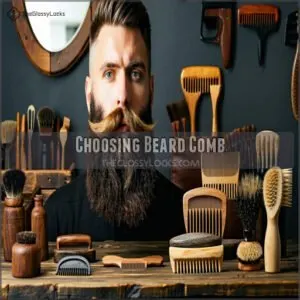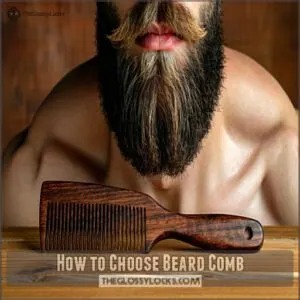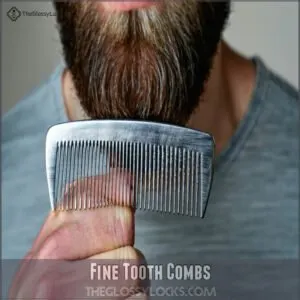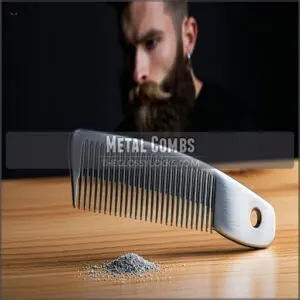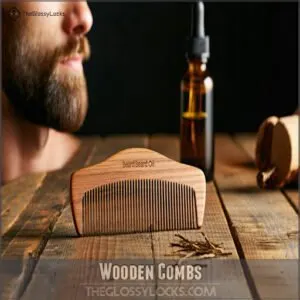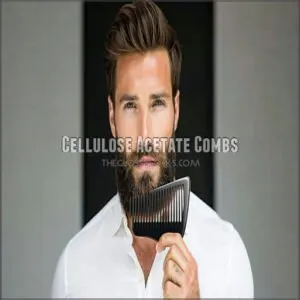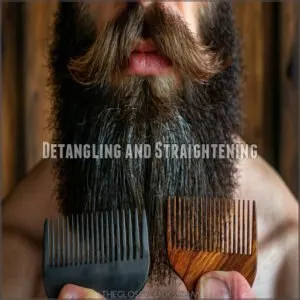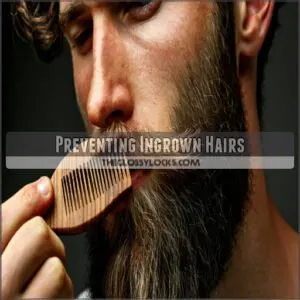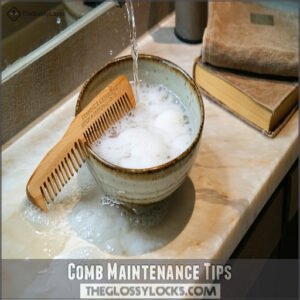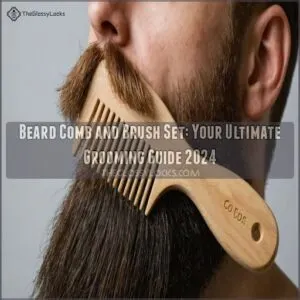This site is supported by our readers. We may earn a commission, at no cost to you, if you purchase through links.
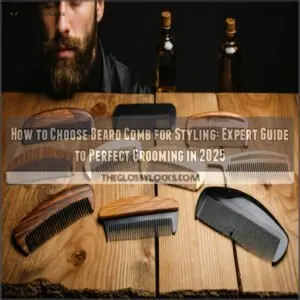 You’ll want to match your beard comb to both length and texture for the perfect styling experience. Beard comb selection is key to achieving the best results.
You’ll want to match your beard comb to both length and texture for the perfect styling experience. Beard comb selection is key to achieving the best results.
For beards under 2 inches, grab a fine-tooth comb for precise control. Sporting a longer mane? A wide-tooth comb will be your best friend.
Material matters too – wooden combs distribute natural oils beautifully, while metal ones offer precision for thicker growth.
If you’re battling curls, opt for wider tooth spacing to prevent snags. For silky-smooth beards, fine teeth work wonders.
The right comb isn’t just about grooming – it’s about maintaining your beard’s health and keeping those stubborn strays in check. Beard’s health is as important as style.
Table Of Contents
- Key Takeaways
- Choosing Beard Comb
- How to Choose Beard Comb
- Beard Comb Types
- Combing Techniques
- Comb Maintenance Tips
- Frequently Asked Questions (FAQs)
- Are wood or plastic combs better for beards?
- Should I get a wide or fine tooth comb for my beard?
- What is the difference between a beard comb and a normal comb?
- Can beard combs be used on wet hair?
- How often should I replace my beard comb?
- Are electric heated beard combs worth buying?
- Do beard combs work differently for gray hair?
- Should beard combs match different facial shapes?
- Conclusion
Key Takeaways
- You’ll need to choose the correct tooth spacing for your beard length – use fine-tooth combs for beards under 2 inches and wide-tooth combs for longer lengths to prevent snagging and tangling.
- Your beard’s texture determines the best comb material – wooden combs distribute natural oils well and prevent static, while metal combs offer precision for thicker growth and cellulose acetate provides anti-static benefits.
- You should start combing from neck to cheeks when detangling, then style downward from cheeks to jawline, ensuring even distribution of oils and balms throughout your beard.
- You’ll want to clean your comb regularly with warm water and mild soap, store it in a dry place, and replace your comb every 6 to 12 months or when you notice damaged teeth or buildup that won’t clean off.
Choosing Beard Comb
You’ll need to match your beard’s unique texture and length with the right comb material and tooth spacing to achieve that perfect, styled look.
Whether you’re rocking a short stubble or a majestic full beard, choosing the right comb will make the difference between a tangled mess and a well-groomed masterpiece.
Beard Length Consideration
When your beard starts to grow out, selecting the right comb becomes essential for proper styling.
For beards under 2 inches, a fine-tooth beard comb works best to manage shorter hair.
As your beard length increases past 2 inches, switch to a wide-tooth beard comb to prevent snagging.
Consider both the comb size and teeth spacing to match your beard growth and length measurement needs.
Beard Texture Analysis
Understanding your facial hair’s unique personality makes all the difference in your grooming game.
If you’ve got a curly beard prone to tangle issues, you’ll need wider teeth spacing to prevent snags.
For coarse hair that tends toward frizzy ends, look for combs that can tackle stubborn knots.
Those blessed with soft texture can opt for finer teeth to achieve that perfectly sculpted look.
Proper beard comb maintenance guarantees the longevity of your comb and ideal beard health.
Comb Material Selection
In light of your unique grooming needs, selecting the right beard comb material makes all the difference.
Wooden combs offer natural oil distribution and durability, while metal options provide precision for thicker beards. Horn benefits include smooth gliding and anti-static properties.
For modern innovation, carbon fiber delivers lightweight durability, and cellulose acetate combines style with functionality.
Proper beard comb maintenance is critical for hygiene and beard health.
Skip plastic beard combs – they’ll damage your facial hair.
How to Choose Beard Comb
You’ll get the best results from your beard grooming when you match the right comb to your facial hair’s length and texture.
Whether you’re working with a short stubble or a majestic full beard, choosing between wide or fine teeth and materials like wood, horn, or cellulose acetate will make a noticeable difference in your styling routine.
Modern Impacts On Society
Everyone’s getting in on the beard grooming revolution, and it’s not just about looking good. Social trends show that your beard comb choice reflects modern urban lifestyle values.
For superior beard health, consider different comb materials like wood or horn.
Cultural shifts have made beard care a symbol of self-expression, with digital influence driving community engagement around grooming practices.
The best beard combs aren’t just tools anymore – they’re statements of personal style and cultural identity.
Key Challenges And Innovations
When you’re choosing your next beard comb, you’ll face two main hurdles: matching the comb to your beard’s unique personality and picking the right material.
Today’s Grooming Trends have brought exciting Hair Innovation – from combs that dispense oils to smart tools with built-in sensors for tracking hair health.
Some Styling Tools even feature massage nodes, while others sport unconventional shapes for better grip and control.
Future Prospects And Directions
Looking ahead, Beard Tech innovations are shaping the future of grooming with exciting developments in comb design and materials.
Proper beard comb maintenance is also indispensable for healthy facial hair.
As your trusted guide in comb selection, here’s what’s on the horizon:
- Smart combs with built-in sensors to analyze beard health and growth patterns
- Eco-friendly materials that combine sustainability with premium performance
- Self-cleaning surfaces that resist bacteria and product buildup
- Temperature-responsive materials that adapt to your beard’s texture
Beard Comb Types
You’ll find five main types of beard combs on the market today: wide tooth, fine tooth, metal, wooden, and cellulose acetate, each designed for specific grooming needs.
Your choice of comb material and tooth spacing will depend on your beard’s length and texture, making it essential to understand the strengths of each type.
Wide Tooth Combs
Your beard’s best friend during detangling sessions is a wide tooth comb. These gentle giants excel at managing thick or curly facial hair without causing damage.
Wide tooth benefits include reduced pulling and minimal breakage, making them perfect for longer beards.
You can find a wide tooth beard comb product online.
The generous spacing between teeth helps distribute beard oils evenly while preventing snags.
For coarse beard textures, they’re an essential grooming tool.
Fine Tooth Combs
Fine tooth combs offer precision control for shorter facial hair styles and detailed grooming. You’ll find these combs particularly effective for mustache maintenance and intricate beard styling.
For those seeking quality options, explore a fine tooth beard comb product. The narrower spacing between teeth helps distribute oils evenly while providing excellent control for precise shaping.
When selecting a fine tooth beard comb, look for smooth, polished teeth to prevent snagging and guarantee comfortable detangling of your facial hair.
Metal Combs
Many beard enthusiasts swear by metal beard combs for their exceptional durability and precision grooming capabilities.
Consider important material considerations when choosing a comb.
When you’re considering metal comb ergonomics, remember these key features:
- Premium stainless steel construction provides lifelong durability
- Hand-polished teeth prevent snagging and reduce static
- Ergonomic handle design provides superior control during styling
While they’re pricier than plastic alternatives, metal combs offer unmatched quality for serious beard maintenance. Just watch out for those sharp teeth initially.
Wooden Combs
While metal combs can feel harsh against your skin, wooden beard combs offer a gentler approach to grooming. The natural wood grain creates smooth teeth that glide through your facial hair, making beard detangling a breeze.
You can find a variety of wooden beard combs online. Handcrafted combs with ergonomic handles provide excellent control, and their wooden durability means they’ll last for years.
Plus, wood beard combs naturally distribute oils and won’t create static electricity like synthetic materials.
Cellulose Acetate Combs
While wooden combs offer natural charm, cellulose acetate combs bring modern innovation to your grooming routine. These non-petroleum based combs, derived from softwood trees, offer unmatched comfort and versatility. You’ll appreciate their smooth, painless glide that helps distribute natural oils while preventing tangles.
- Antistatic properties keep frizz at bay during styling
- Perfect for quick touch-ups throughout your day
- Works exceptionally well with all beard lengths and textures
Combing Techniques
You’ll master your beard’s appearance with the right combing method, which starts at the neck and moves upward to work out tangles before styling downward.
Once you’ve removed any knots, you can transform your facial hair into the perfect style by combing from your cheeks down toward your jawline.
Making sure to distribute oils and balms evenly through your beard.
Daily Combing Routine
Establishing a daily beard combing routine transforms your facial hair from unruly to well-groomed. daily beard combing routine Start your morning styling by moisturizing your beard, then use your chosen comb to work through your beard in sections.
Begin at your neckline and work upward, then comb downward to shape. For effective hair growth and maintenance, repeat this beard care ritual 2-3 times daily, especially after washing or applying products.
Detangling and Straightening
When your beard becomes a maze of knots, proper detangling technique makes all the difference.
Start with a wide-tooth comb at the tips, gradually working upward to free stubborn tangles.
For maximum frizz control, switch to a fine-tooth comb once the major knots are gone.
Work in sections, using gentle strokes for beard alignment.
You’ll achieve smoother, more manageable facial hair without the frustration of yanking or pulling.
Distributing Beard Oils
Now that your beard is detangled, let’s make those oils work harder for you. Your comb isn’t just a styling tool – it’s your secret weapon for perfect oil distribution and beard moisture management.
- Use downward strokes to spread oils evenly from roots to tips
- Choose wooden combs for better oil absorption and natural distribution
- Work in sections to make sure complete beard hydration
- Comb both against and with the grain for thorough coverage
- Wait 2-3 minutes after oil application before combing
A quality beard comb guide shows that proper oil distribution transforms a dry, unruly mane into a well-groomed masterpiece. Remember, consistent beard care starts with the right combing technique.
Preventing Ingrown Hairs
While regular combing helps prevent ingrown hairs, you’ll need the right technique for effective beard health.
Start by using your beard comb to gently lift hair from the skin’s surface, combing in the direction of growth. This gentle combing technique helps train your facial hair upward, reducing the chance of painful ingrowth while ensuring proper skin protection.
Remember, patience and consistency are key to preventing those pesky ingrown hairs.
Comb Maintenance Tips
You’ll get more mileage from your beard comb if you treat it right, just like any other grooming tool in your arsenal.
A quick rinse with warm water and mild soap after each use, followed by proper storage in a dry place, will keep your comb clean and ready for years of perfect beard styling.
Cleaning and Sanitizing
Keeping your beard comb pristine isn’t just about looks – it’s essential for maintaining a healthy grooming routine.
Start by soaking your comb in warm water mixed with gentle soap, focusing on bacterial removal between the teeth.
Use a soft brush to scrub away buildup, paying special attention to product residue.
Rinse thoroughly and pat dry with a clean cloth before letting it air dry completely.
Storing and Replacing
You’ll want to store your beard comb in a dry, protected space to prevent damage and bacterial growth. A dedicated drawer or travel case works perfectly for pocket beard combs, while larger combs need more space.
Check your comb’s handle durability monthly – if you notice cracks, chips, or missing teeth, it’s time for a replacement. Consider switching combs every 6-12 months for effective beard care.
Avoiding Static Buildup
Static electricity can turn your grooming routine into a flyaway nightmare. To combat this, choose anti-static materials like horn beard combs or a wooden comb that naturally resist electric charges. Your hair texture plays a key role in static buildup – coarser beards typically generate more static than fine ones.
- Use cellulose acetate combs with antistatic properties to keep your beard smooth.
Extending Comb Lifespan
Through proper care, your beard comb can last for years.
Clean the teeth weekly with warm water and mild soap to prevent oil buildup. Choosing the best beard comb material is important for beard health.
Store your comb in a dry place, away from direct sunlight that can weaken materials. For wooden combs, apply mineral oil monthly to prevent drying.
Handle your comb gently, especially when detangling, and avoid dropping it to maintain tooth alignment.
Frequently Asked Questions (FAQs)
Are wood or plastic combs better for beards?
Wood combs are your best bet over plastic ones. They don’t create static, distribute oils naturally, and won’t snag your beard hair. Plus, they’re durable and look great on your bathroom counter.
Should I get a wide or fine tooth comb for my beard?
90% of beard grooming mistakes come from using the wrong comb tooth width.
You’ll need both: start with a wide-tooth comb to detangle, then switch to fine-tooth for precise styling and shaping.
What is the difference between a beard comb and a normal comb?
Unlike regular combs, your beard comb‘s teeth are spaced wider and cut smoother to handle coarse facial hair without snagging.
They’re also crafted from materials that won’t create static or damage your beard.
Can beard combs be used on wet hair?
Excessive moisture can cause 73% more damage to your beard.
You shouldn’t use your beard comb on soaking wet hair – wait until it’s damp, then gently work through tangles to prevent breakage.
How often should I replace my beard comb?
You’ll need to replace your comb every 6-12 months with regular use.
If you notice any broken teeth, rough edges, or residue buildup that won’t clean off, it’s time for a new one.
Are electric heated beard combs worth buying?
While heated beard combs might seem trendy, you’ll get better results from a quality traditional comb paired with beard oil.
They’re often expensive and can damage your facial hair through excessive heat exposure.
Do beard combs work differently for gray hair?
Gray beard hair tends to be coarser and more wiry.
You’ll want a wide-toothed wooden or horn comb. These materials won’t create static and will help distribute oils through your silver strands.
Should beard combs match different facial shapes?
Your facial shape doesn’t dictate the comb you’ll need.
Instead, focus on your beard’s length and texture.
You’ll want wide teeth for thick growth and fine teeth for detailed styling around your features.
Conclusion
Picture yourself confidently styling your beard each morning with the perfect comb in hand.
Now that you know how to choose a beard comb for styling based on your beard’s length and texture, you’re ready to elevate your grooming game.
Remember, whether you opt for wide-tooth wooden combs for your majestic mane or fine-tooth metal precision for shorter styles, the right tool makes all the difference.
Your beard deserves this attention to detail – it’s the frame for your face, after all.
- https://medium.com/@randyhernandez_78611/how-to-choose-a-beard-comb-ab5858367fa
- https://www.goldenbeards.com/blogs/news/choose-right-beard-comb
- https://www.beardbrand.com/blogs/urbanbeardsman/best-beard-comb
- https://manlinesskit.com/beard-comb-or-brush-choosing-the-right-tool/
- https://huskybeard.com/blogs/better-beard-blog/best-beard-comb

